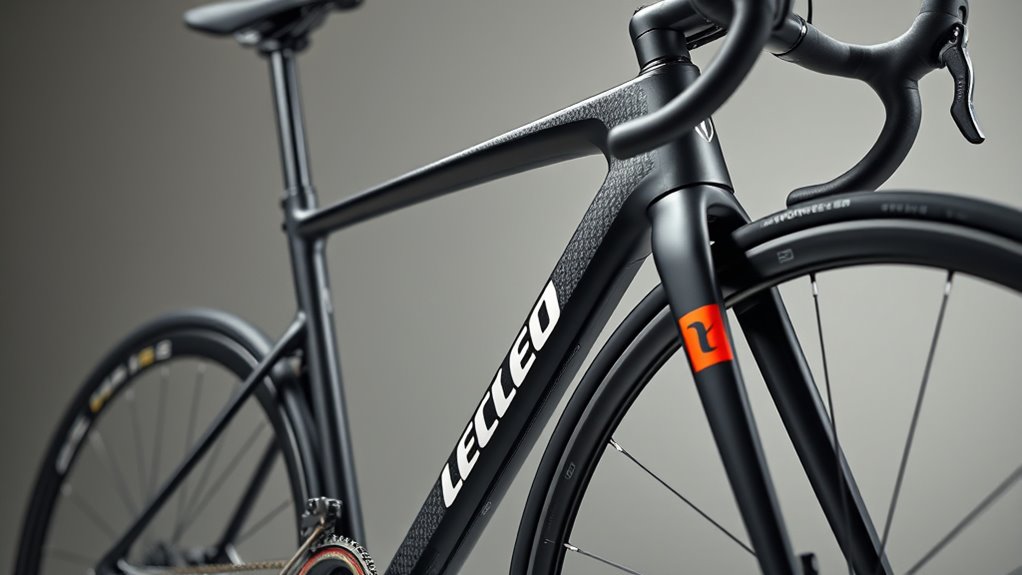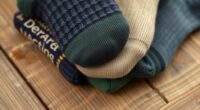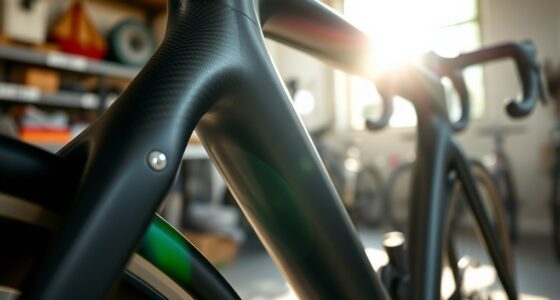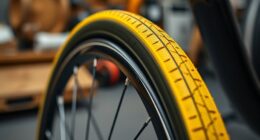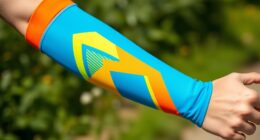You can produce race-ready bike parts in just 24 hours using 3D printing, giving you a competitive edge. This technology allows for rapid prototyping, personalized designs, and lightweight, durable components made from advanced materials. By streamlining your workflow and customizing parts to your exact needs, you can test and refine designs quickly. If you want to discover how teams are winning races with fast, innovative 3D-printed parts, stick around for more insights.
Key Takeaways
- Rapid 3D printing enables quick development and testing of race-specific, lightweight bike components within 24 hours.
- Customization of parts improves fit, aerodynamics, and performance tailored to individual rider needs.
- Advanced materials like carbon composites enhance durability, reducing fatigue and increasing safety during races.
- Digital modeling and simulation streamline design adjustments, accelerating the production cycle for competitive edge.
- On-demand, rapid prototyping allows teams to adapt parts swiftly to evolving race conditions and technical feedback.
The Rise of 3D Printing in Cycling Innovation

3D printing has revolutionized cycling innovation by allowing manufacturers and enthusiasts to quickly prototype and produce custom bike parts. Historically, this technology’s emergence marked a turning point, enabling rapid development and testing of new designs. Over the past decade, the market growth for 3D-printed bike components has surged as more brands and riders recognize its potential. Early adopters paved the way, demonstrating how 3D printing could reduce costs and lead times compared to traditional manufacturing. Today, the industry continues to expand, with a growing number of companies integrating 3D printing into their workflows. This shift not only accelerates innovation but also democratizes access, empowering more cyclists to create personalized parts tailored to their specific needs. The market’s rapid growth signals a lasting impact on cycling’s future. Incorporating self‑understanding can help manufacturers better tailor products to meet individual rider preferences and needs, especially as 3D printing facilitates customization and on-demand production.
Benefits of Rapid Prototyping for Race-Ready Components

Rapid prototyping speeds up your development process, letting you test and refine bike parts faster than traditional methods. It also offers you the flexibility to customize components precisely to your needs, enhancing performance. This approach empowers you to bring race-ready designs to life quickly and efficiently. Additionally, techniques like 3D printing enable the creation of complex, lightweight parts that improve overall bike performance.
Accelerated Development Cycles
Because race teams need to iterate quickly to stay competitive, using 3D printing for prototyping markedly accelerates development cycles. This technology allows you to test and refine components rapidly, leading to more effective design optimization. By quickly producing multiple iterations, you can identify the best configurations without long delays. Material innovation plays a pivotal role here, as new printable materials offer strength, durability, and lightweight properties essential for racing. This fast-paced process means you spend less time waiting on manufacturing and more time improving performance. Overall, 3D printing streamlines development, enabling you to bring race-ready parts to the track faster than traditional methods, ultimately giving you a competitive edge. Incorporating rapid prototyping techniques ensures continuous innovation and higher quality in your racing components. Additionally, utilizing beneficial ingredients like collagen and hyaluronic acid in related fields demonstrates how targeted enhancements can improve product effectiveness.
Customization and Flexibility
One of the biggest advantages of 3D printing in racing is its ability to deliver highly customized, race-ready components tailored to your specific needs. This flexibility means you can create parts that optimize performance, fit perfectly, and showcase unique aesthetic appeal. Rapid prototyping allows you to experiment with different designs quickly, giving you a competitive edge and enhancing your marketing strategies by highlighting innovation. You can modify features on the fly, reducing time and costs compared to traditional methods. This adaptability empowers you to respond swiftly to feedback, refine details, and ensure every part aligns with your racing goals. Additionally, understanding how color accuracy influences visual quality can help in designing components with clear and precise detailing. Recognizing the importance of material selection in 3D printing can further improve the durability and functionality of your race components. Moreover, considering frost prevention techniques ensures your parts maintain optimal performance in harsh conditions. Incorporating UV filters can also protect your printed components from sun damage, prolonging their lifespan during races.
Materials and Techniques Used in 3D Bike Part Production
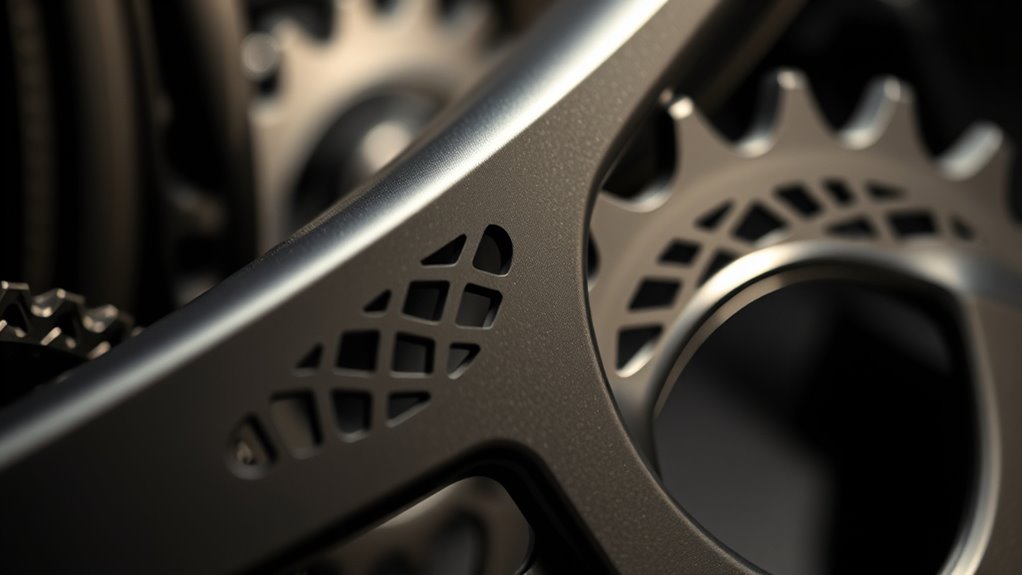
When producing 3D bike parts, you have access to advanced printing materials that offer strength and durability. Innovative manufacturing techniques enable precise customization and complex designs tailored to your needs. This flexibility allows you to optimize performance and aesthetics with a variety of materials and methods. Additionally, incorporating Mazda Tuning techniques can inspire innovative design modifications for enhanced functionality and style. Implementing SQA Best Practices ensures consistent quality and reliability throughout the manufacturing process. Moreover, selecting suitable material properties is crucial for meeting the specific demands of racing environments.
Advanced Printing Materials
Advancements in printing materials have considerably expanded the possibilities for creating durable and lightweight bike parts through 3D printing. You can now select specialized materials that enhance biomechanical optimization and aerodynamic enhancements, giving racers a competitive edge. These advanced materials include carbon fiber composites, high-performance thermoplastics, and metal alloys, each offering strength, flexibility, and reduced weight. They enable precise customization of parts for specific rider needs and race conditions. The table below highlights some key materials and their properties:
| Material | Strength & Flexibility | Ideal Use |
|---|---|---|
| Carbon Fiber Composites | High strength, lightweight | Frame components, handlebars |
| Nylon with Reinforcements | Durable, impact-resistant | Pedals, mounts |
| Titanium Alloys | Corrosion-resistant, strong | Critical structural parts |
| PETG & ABS | Easy to print, versatile | Custom accessories |
Innovative Manufacturing Techniques
Innovative manufacturing techniques have revolutionized how 3D printed bike parts are produced, combining advanced materials with precise fabrication methods. You now benefit from techniques like additive manufacturing, enabling complex geometries and lightweight designs that weren’t possible with traditional methods. Biomechanical analysis plays a vital role, ensuring parts are optimized for strength, durability, and rider comfort. These approaches stand in contrast to historical manufacturing, which relied on subtractive machining and casting—methods slower and less adaptable. Today’s techniques allow rapid prototyping and on-demand production, reducing waste and lead times. As a result, you can develop highly specialized components tailored to specific performance needs, gaining a competitive edge in races. This fusion of biomechanics and innovative fabrication redefines how bike parts are designed, tested, and manufactured. Additionally, open dialogue and vulnerability in communication between designers and engineers foster innovative solutions and continuous improvement in the manufacturing process. Recognizing the importance of advanced materials in 3D printing enables the creation of bike parts that are both lightweight and resilient, further enhancing performance. Furthermore, incorporating personalized design through 3D printing allows for customized fit and function, optimizing each rider’s unique biomechanics. Moreover, understanding the role of wave and wind dynamics can lead to better aerodynamic designs and improved riding efficiency. The integration of digital modeling and simulation also accelerates development cycles and enhances precision in creating components.
Customization and Flexibility
You can customize and adapt your bike parts more easily with a variety of advanced materials and flexible manufacturing techniques. 3D printing enables you to select from lightweight composites, durable plastics, and even metal alloys, allowing you to tailor components to your specific riding style and performance needs. This flexibility reflects historical trends in manufacturing, where customization has become essential for competitive advantage. As market growth accelerates, more options are available for personalized bike parts. Consider these key advantages:
- Rapid prototyping for quick adjustments
- Material versatility for strength or weight reduction
- On-demand production for unique designs
- Manufacturing hours have become more flexible to meet the increasing demand for customized parts.
Additionally, the ability to incorporate customized features directly into designs enhances performance and rider satisfaction. This ongoing innovation is driven by the demand for personalized options that can improve efficiency and competitiveness on the racecourse.
This evolving landscape empowers you to optimize your bike setup efficiently, keeping pace with technological innovations and market demands.
Customization and Personalization for Optimal Performance
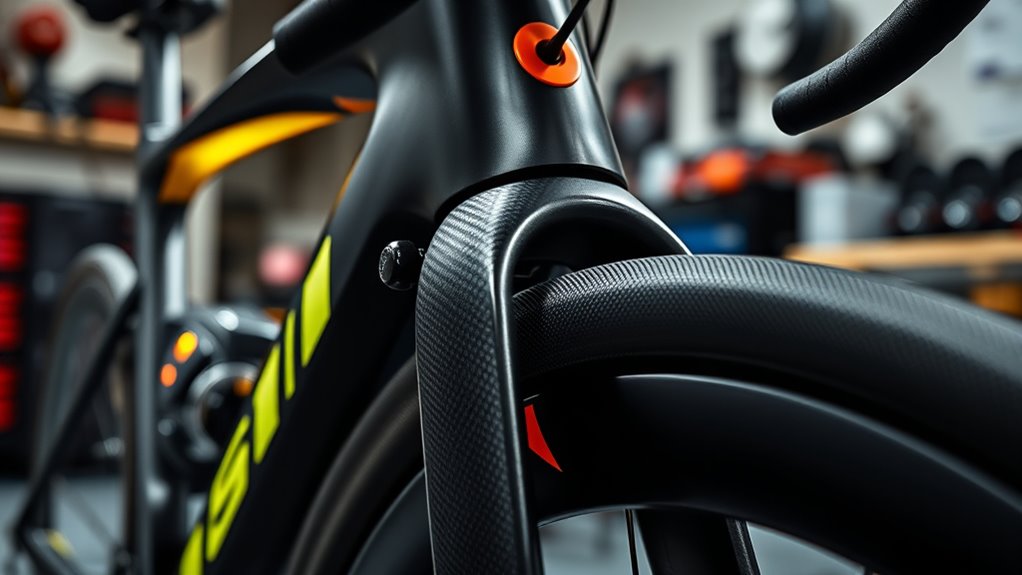
Because every rider has unique preferences and body mechanics, 3D printing enables precise customization of bike parts to boost performance. You can tailor components for ideal fit, weight reduction, and aerodynamics, ensuring your bike works perfectly for you. This technology also offers matching aesthetics, allowing you to design parts that complement your bike’s overall look, giving you a competitive edge. Personalization extends beyond function—branding opportunities let you add logos or unique designs, making your bike stand out on the racecourse. With rapid production times, you can experiment with different configurations and styles without long delays. Additionally, 3D printing allows for the creation of customized tire sizes that suit specific terrain needs, helping you push limits, ultimately enhancing your speed, comfort, and confidence during races. Incorporating advanced materials can further improve durability and weight savings, ensuring your components withstand the rigors of competitive cycling. Moreover, understanding benefits of raw food can inspire innovative approaches to nutrition and recovery in athletic training.
Streamlining the Design Process With Additive Manufacturing

Additive manufacturing considerably accelerates the design process by allowing rapid prototyping and immediate iteration. You can quickly test ergonomic design improvements, ensuring comfort and efficiency. Plus, it simplifies material recycling, reducing waste and environmental impact. To streamline your workflow, focus on these key benefits:
- Faster Development Cycles: Quickly produce and modify bike parts, cutting weeks off traditional timelines.
- Enhanced Ergonomic Design: Use additive manufacturing to refine shapes that optimize rider comfort and performance.
- Sustainable Material Use: Recycle unused material efficiently, promoting eco-friendly practices while maintaining high-quality standards.
This approach lets you innovate faster, improve ergonomics, and support sustainability—all essential for winning races and pushing biking limits.
Case Studies: Winning Races With 3d-Printed Parts

In these case studies, you’ll see how 3D-printed parts help teams achieve faster production cycles and better customization options. These innovations also lead to significant weight reductions, giving racers a competitive edge. By exploring real-world examples, you’ll understand how additive manufacturing transforms racing performance.
Faster Production Cycles
The adoption of 3D printing has revolutionized how quickly bike manufacturers can produce critical components for racing, giving teams a significant edge on the track. This shift aligns with historical trends showing faster turnaround times and reduced manufacturing costs. With 3D printing, you can:
- Cut production timelines from weeks to hours, enabling rapid prototyping and immediate testing.
- Lower costs by eliminating expensive tooling and molds, making quick iterations feasible.
- Respond swiftly to race demands, customizing parts on short notice and staying ahead of competitors.
These faster production cycles mean you can iterate designs more efficiently, optimize performance, and stay competitive in the fast-paced world of racing. 3D printing’s rapid turnaround fundamentally changes how teams approach manufacturing and innovation.
Enhanced Customization Options
Because 3D printing allows for precise, on-demand customization, you can tailor bike parts to match specific rider needs and race conditions. This flexibility enhances aesthetic appeal, letting you design parts that not only perform well but also stand out visually. You can experiment with unique shapes, colors, and textures that reflect your style or team branding. Additionally, 3D printing reduces costs by enabling you to produce only what’s needed, avoiding excess inventory or expensive mass manufacturing. This customization capability means you can quickly adapt parts to changing race strategies or rider preferences, giving you a competitive edge. Overall, 3D printing empowers you to create highly personalized, visually appealing bike components while keeping costs in check.
Weight Reduction Benefits
By reducing weight through 3D-printed bike parts, racers can gain a significant competitive advantage on the track. Lighter components improve speed, agility, and handling, giving you an edge over rivals. Plus, 3D printing allows for innovative designs that enhance ergonomic comfort without adding weight. Here are three key benefits:
- Improved Performance: Lighter parts reduce rider fatigue and boost acceleration, making every second count.
- Enhanced Aesthetic Design: Custom shapes and finishes make your bike stand out while staying lightweight.
- Optimized Ergonomic Comfort: Precise, lightweight parts improve fit and reduce strain, increasing rider confidence.
Overcoming Challenges: Durability and Safety Considerations

Although 3D-printed bike parts offer exciting customization and rapid production, ensuring their durability and safety remains a significant challenge. You need to address material fatigue, which can weaken parts over time, risking failure during races. Rigorous safety testing is essential to identify weak points and confirm reliability under stress. Without thorough testing, you might face unexpected breakages that compromise your safety and performance. The table below highlights key considerations:
| Challenge | Solution |
|---|---|
| Material fatigue | Use durable, tested materials |
| Safety testing | Conduct stress analysis |
| Long-term reliability | Regular inspections |
The Future of 3D Printing in Competitive Cycling

The future of 3D printing in competitive cycling looks promising as technology continues to advance, enabling you to push the boundaries of performance and customization. Historically, 3D printing has evolved from rapid prototyping to producing race-ready parts, reflecting steady market adoption. This shift means you’ll soon see more personalized, lightweight components on the podium. Consider these key developments:
3D printing will transform competitive cycling with faster, stronger, and more personalized bike components.
- Increased material variety for stronger, more durable parts.
- Faster printing speeds, reducing turnaround times for custom orders.
- Broader market acceptance, making 3D-printed bike parts more accessible to teams and individuals alike.
These trends suggest that 3D printing will become integral to competitive cycling, revolutionizing how you design, build, and optimize your bike for race day.
Environmental Impact and Sustainability Aspects

As 3D printing transforms bike manufacturing, its environmental impact becomes an essential consideration. You can diminish waste through recycling initiatives, which repurpose failed prints and excess material, minimizing landfill contributions. Using eco friendly materials like biodegradable filaments or recycled plastics further enhances sustainability. These materials lower the carbon footprint compared to traditional manufacturing processes. By adopting recycling initiatives and eco conscious materials, you contribute to a greener industry and promote responsible use of resources. Additionally, 3D printing’s localized production reduces transportation emissions, further lowering environmental impact. Overall, integrating sustainable practices ensures that innovative bike components not only perform well but also support long-term environmental health. This approach aligns cutting-edge technology with eco-conscious values, making your racing efforts more sustainable.
How Teams Integrate 3D Printing Into Their Workflow

Integrating 3D printing into a team’s workflow requires strategic planning and collaboration across departments. To maximize benefits like print quality and cost efficiency, you should focus on three key steps:
Effective 3D printing integration demands strategic planning and cross-department collaboration for optimal results.
- Streamlining Design and Prototyping: Use CAD software to quickly develop and test parts, reducing iteration time.
- Optimizing Print Settings: Adjust parameters for ideal print quality, minimizing material waste and saving costs.
- Establishing Clear Communication: Maintain open channels between designers, engineers, and manufacturing to ensure seamless integration and rapid problem-solving.
Frequently Asked Questions
How Do 3d-Printed Bike Parts Compare to Traditionally Manufactured Components?
You’ll find that 3D-printed bike parts excel in design flexibility, allowing you to create complex, lightweight structures that traditional manufacturing can’t easily achieve. While material durability might vary depending on the material used, advancements have improved their strength substantially. Compared to traditional components, these parts often offer quicker customization and faster production, giving you a competitive edge in races. Overall, 3D printing is transforming how you approach bike design and performance.
What Are the Cost Implications of Using 3D Printing for Bike Parts?
You’ll find that using 3D printing for bike parts can reduce material costs, especially for small batches or custom components. The increased production efficiency means you spend less time on manufacturing, cutting labor expenses. While initial setup might be higher, long-term savings are notable because you avoid costly tooling and can quickly iterate designs. Overall, 3D printing offers a cost-effective solution for innovative and personalized bike parts.
Can 3d-Printed Parts Withstand Extreme Racing Conditions?
You might wonder if 3D-printed parts can handle extreme racing conditions. The good news is, with advances in material durability, these parts now withstand high stress, heat, and vibration. Plus, manufacturing flexibility allows for custom designs to optimize strength and performance. While not all 3D-printed components are suitable for every race, many are now reliable enough for demanding environments, giving you an edge on the track.
How Long Does It Typically Take to Produce a Custom Bike Component via 3D Printing?
Back in the day, you’d wait weeks for custom parts, but now, 3D printing speeds things up. Typically, it takes anywhere from a few hours to a day to produce a bike component. Your process involves careful material selection and efficient post-processing techniques to guarantee quality. The actual printing time depends on the complexity and size of the part, making it a quick, flexible solution for custom cycling needs.
Are There Any Regulatory or Safety Standards for 3d-Printed Cycling Parts?
When considering 3D-printed cycling parts, you’ll find regulatory hurdles and safety testing are key concerns. Manufacturers must meet industry standards and pass rigorous safety testing to guarantee durability and rider safety. While regulations are evolving, it’s crucial to stay informed about local guidelines and certifications. This guarantees your custom parts are not only innovative but also compliant, giving you confidence in their performance and safety during races or daily rides.
Conclusion
Imagine a race where every part is born in just a day, tailored perfectly to your ride, like a custom suit molded to your body. 3D printing transforms the cycling world into a blazing trail of innovation, where speed and precision dance hand in hand. As technology accelerates, you’ll find yourself riding on the cutting edge, where breakthrough designs and sustainability pave the way for a future as bright and limitless as the open road ahead.
